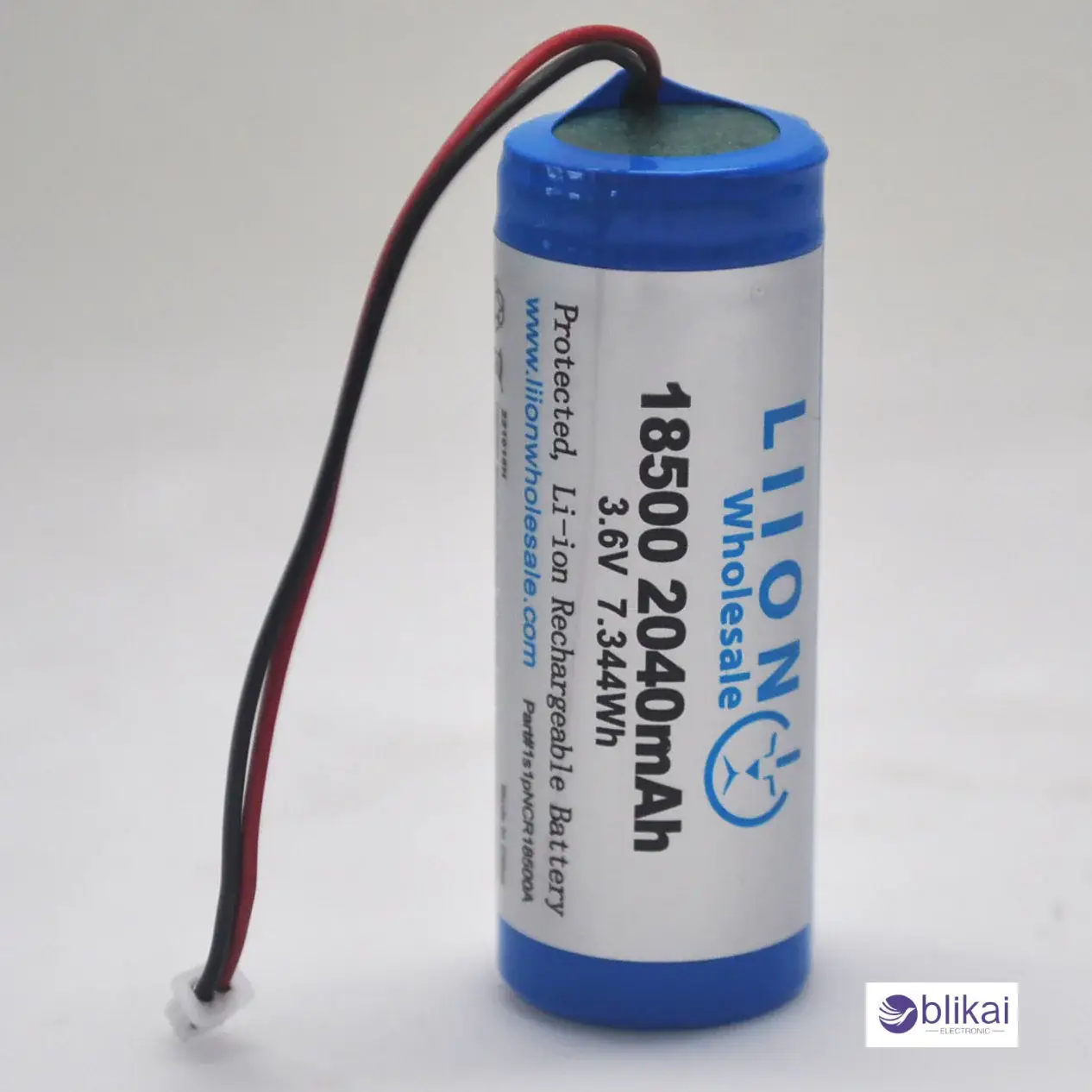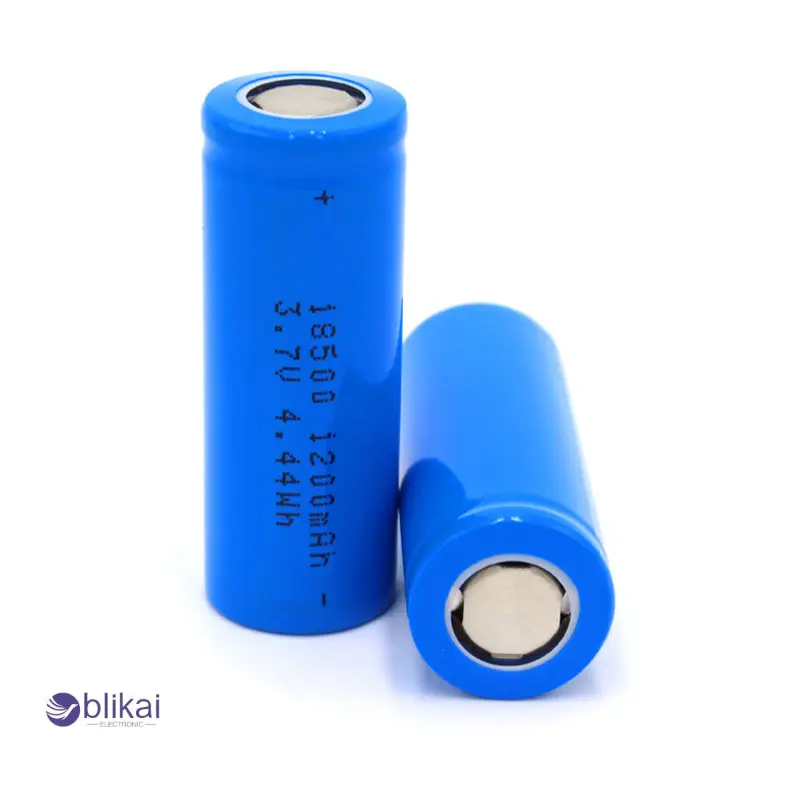18500 Battery: Features, Applications & Comparison
What is a 18500 Battery?
The 18500 battery is a lithium-ion battery that can be charged again. This is referred to as 18500 because its diameter is 18 mm and its length of 50 mm. They will have a current of 3.7 volts, or the standard of most lithium-ion cells, and operate at 1200mAh to 2000mAh. A tremendous volume of objects in flashlights, electric toys, and medical equipment use the 18500 type of battery, which is a well-known, stable source of power.

Specifications of the 18500 Battery
Voltage:
This battery is 3.7 nominal volts, with a typical voltage of a lithium-ion battery being 3.7 volts. It is this voltage that will then suffice to power up a wide range of low to medium-powered devices. The volts at which the battery will discharge are approximately 3.0 volts, and the charge volts at which the battery will charge are approximately 4.2 volts.
Discharge Rate:
A 18500 battery will generally emit as much as 2C to 5C. This indicates that it is capable of providing vast quantities of current in short bursts without harming the battery, such that it will fit in the middle range of power consumption.
Internal Resistance:
The internal resistance of the 18500 battery is comparatively low, and this aspect has guaranteed that it can easily transmit power with minimal energy loss. The feature is imperative in maintaining stable operation under the conditions of high-power load since less internal resistance would translate to less heat production and greater efficiency of the battery, in general.
Weight:
The weight of the battery 18500 is approximately 30-40 g. It is comparatively lightweight, hence suitable for gadgets that require a portable source of power, and will not be too bulky for those gadgets.
Lifespan:
The 18500 battery can give 300-500 charge cycles before it becomes very ineffective in its operations. Following the best practice of charging and storage, the 18500 may remain a stable power supply for a few years.
Comparison Between the 18500 Battery and Other Batteries
In the case of the 18500 battery, it is wise to compare it to some degree with other types of batteries that are commonly used so that its benefits and weaknesses may be better understood. The most related ones are 18650 and CR123A batteries, and whether the 18500 is equivalent to a regular AA battery.
Do 18500 Batteries have the same thing as AA Batteries?
18500 batteries cannot fit the normal AA batteries, although they have the same diameter (18 mm). In contrast to 18500 batteries, AAT batteries are alkaline-based and NiMH (nickel-metal hydride) based. The voltage and energy storage are major differences between these two types of battery. The current on AA batteries is usually 1.5 or 1.2 volts (alkaline, NiMH, respectively) in comparison with 3.7 volts of the 18500 lithium-ion battery. Further, AA batteries are generally used in domestic devices (remote controls, clocks, playthings, and so on); however, the 18500 batteries are generally used in more specialized applications (like flashlights, medical devices, and high-performance electronics), where higher current and rechargeability ought to be possible.
18500 Battery vs. 18650 Battery
The 18650 Li-ion battery consists of 18. typically 65mm and 18 mm in length, which is far bigger than 18500. and is called a 18650 battery. The larger size enables the 18650 to support a high 2500mAh to 3500mAh capacity suitable for highly-demand applications, such as electric cars or laptops and power tools. The 18650 will be able to deliver power; moreover, it will be larger, to the extent that it will not fit into small equipment. The smaller 18500 will have moderate capacities (1200mAh to 2000mAh) and will be better suited to the devices requiring less power than 18650 and will have a longer run time than smaller batteries, such as the 14500.
18500 Battery vs. CR123A Battery
The commonly employed is the lithium cell, which is denoted as CR123A, with a width of 17mm and a length of 34mm. The CR123A is, however, not a rechargeable battery, unlike the 18500. but a single-use battery. CR123A voltages are also slightly lower than the nominal voltage of the 18500. of 3.7 volts, with 1500 mAh or greater capacities. The CR123A also has a compact design and, with an added capacity of yielding high output in short bursts, as compared to the rest of the batteries; therefore, it can be used with other gadgets like cameras and flashlights. However, since it is not rechargeable, this will compel the user to replace it frequently, which will be more expensive in the long-term perspective compared to the rechargeable 18500.
18500 Battery vs. 21700 Battery
The lithium-ion cell is the 21700. 70 mm long and 21mm in diameter, but with much greater capacity, of 4000 mAh to 5000 mAh. This enables the 21700 to be used in high-power equipment such as electric cars and drones. The 21700 is more powerful, but being larger than the 18500. the latter is superior in fitting devices that cannot afford to be bigger, but do require some moderate power output.

Common Applications of the 18500 Battery
Flashlights:
A portable flashlight is one of the most widespread applications of the 18500 battery. The 3.7V output and middle capacity (1200 mAh to 2000 mAh) give it a stable power source to flashlights with high performance in a compact size. The batteries have enabled flashlights to have light and stable output, and at the same time make the device light and portable. The 18500 is used in many tactical flashlights, camping lights and emergency lighting systems because they are portable and their performance is effective.
Electronic Toys:
Electronics toys and remote-controlled items are another item that is frequently manufactured using the 18500. It is of moderate capacity, that is, it is able to provide toys, small robots, and remote-controlled vehicles with sufficient energy without the generation of excessive weight and size. These devices tend to require a light battery capable of providing short bursts of power, and the 18500 is quite good at it since it can discharge.
Medical Devices:
Some medical devices, particularly portable devices, operate on 18500 batteries. These batteries are more popular in portable oxygen concentrators and small medical sensors, as well as blood glucose meters, because they are small and rechargeable.
Vape Pens and E-Cigarettes:
These vape pens and other miniature electronic cigarette devices commonly carry the 18500 batteries because of their size and rechargeability. These batteries are powerful enough to vaporize liquids and yield enough energy to make sure of steady functioning over a long period of time.
Power Banks and Small Chargers:
The 18500 battery is also used in many portable power banks and small chargers as an energy storage in a small and efficient format. The 18650 or 21700 cell size is employed in larger power banks, but the 18500 is a decent size ratio option for smaller on-the-go charging solutions.
Cameras and Flash Units:
Cameras and flash units that need portable power systems often take a 18500 battery, particularly those that are smaller and compact in their appearance. These are based on the fact that the 18500 can deliver power fast and yet be compact and lightweight.
Personal Safety Devices:
Other personal safety gadgets such as personal alarms, self-defence flashlights and portable stun guns also use the 18500 battery. These gadgets must be portable and easily carryable, and the best one is a small 18500.
Conclusion
The battery 18500 offers an optimal ratio of size to voltage and capacity, which makes it an ideal choice as a device that requires reliable and efficient power in a smaller size. It is sufficiently versatile to serve as the power source in a great variety of gadgets, such as flashlights and toys, as well as medical equipment and vape pens. Although it is not as potent as bigger batteries such as the 18650 or 21700. it has a very important application in those devices that require a moderate amount of power with a minimum size.
FAQ
Is it possible to use a 18500 battery instead of a 18650?
No, the 18650 is larger and of higher capacity (2500 mah all the way to 3500 mah) than is the 18 500. The 18650 is essentially undrivable with the 24V and the 5V, with the high-drain cases permitting much superior driving of the former.
Is it possible to replace an AA battery with a 18500 battery?
No, however, the 18500 is the same diameter as AA batteries, only that it runs on high voltage (3.7 V vs. 1.5 V) and is a lithium-ion rechargeable battery, not alkaline or NiMH as AA is.
Is the 18500 battery rechargeable?
Yes, it is a lithium-ion rechargeable battery when compared to the CR123A, which is a non-rechargeable battery. This renders the 18500 to be more cost-effective on devices that need to be powered on many times over.
What is the discharge rate of the 18500 battery?
The 18500 discharge rate is usually between 2C and 5C, thus capable of providing high currents in the short term, hence it is effective in the medium power range.
How long does the 18500 battery last?
The 18500 battery normally lives to 300 to 500 charge cycles, again depending on usage and maintenance and can provide good power for a number of years with proper care.
Some images are sourced online. Please contact us for removal if any copyright concerns arise.
NiCd Battery vs NiMH Battery: Differences
Boat Battery: Types, Chemistry & How to Choose
Battery Isolator Explained: Functions, Types & How to Choose
UPS Battery Guide: Types, Lifespan, Replacement & Safety Tips
2 Gauge Battery Cable: Applications, Features & Comparisons
C Battery vs AA, AAA, D & 9V Battery: Differences
6V Battery vs 12V Battery: Features, Applications & Performance
Automotive Battery Guide: 24F Battery vs 27F Battery Explained
SR927W Battery Guide: Specs, Equivalents, & Replacement
18350 Battery: Size, Applications, & Comparisons










